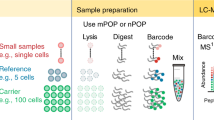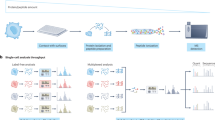Abstract
Researchers in many biological areas now routinely characterize proteins by mass spectrometry. Among the many formats for quantitative proteomics, stable-isotope labelling by amino acids in cell culture (SILAC) has emerged as a simple and powerful one. SILAC removes false positives in protein-interaction studies, reveals large-scale kinetics of proteomes and — as a quantitative phosphoproteomics technology — directly uncovers important points in the signalling pathways that control cellular decisions.
This is a preview of subscription content, access via your institution
Access options
Subscribe to this journal
Receive 12 print issues and online access
$189.00 per year
only $15.75 per issue
Buy this article
- Purchase on Springer Link
- Instant access to full article PDF
Prices may be subject to local taxes which are calculated during checkout



Similar content being viewed by others
References
Aebersold, R. & Mann, M. Mass spectrometry-based proteomics. Nature 422, 198–207 (2003).
Washburn, M. P., Wolters, D. & Yates, J. R. 3rd. Large-scale analysis of the yeast proteome by multidimensional protein identification technology. Nature Biotechnol. 19, 242–247 (2001).
Gygi, S. P. et al. Quantitative analysis of complex protein mixtures using isotope-coded affinity tags. Nature Biotechnol. 17, 994–999 (1999).
Ong, S. E. et al. Stable isotope labeling by amino acids in cell culture, SILAC, as a simple and accurate approach to expression proteomics. Mol. Cell. Proteomics 1, 376–386 (2002).
Blagoev, B. et al. A proteomics strategy to elucidate functional protein–protein interactions applied to EGF signaling. Nature Biotechnol. 21, 315–318 (2003).
Ong, S. E. & Mann, M. Mass spectrometry-based proteomics turns quantitative. Nature Chem. Biol. 1, 252–262 (2005).
Julka, S. & Regnier, F. Quantification in proteomics through stable isotope coding: a review. J. Proteome Res. 3, 350–363 (2004).
MacCoss, M. J. & Matthews, D. E. Quantitative MS for proteomics: teaching a new dog old tricks. Anal. Chem. 77, 294A–302A (2005).
Yan, W. & Chen, S. S. Mass spectrometry-based quantitative proteomic profiling. Brief Funct. Genomic. Proteomic. 4, 27–38 (2005).
Wright, M. E., Han, D. K. & Aebersold, R. Mass spectrometry-based expression profiling of clinical prostate cancer. Mol. Cell. Proteomics 4, 545–554 (2005).
Kuster, B., Schirle, M., Mallick, P. & Aebersold, R. Scoring proteomes with proteotypic peptide probes. Nature Rev. Mol. Cell Biol. 6, 577–583 (2005).
Gehrmann, M. L., Hathout, Y. & Fenselau, C. Evaluation of metabolic labeling for comparative proteomics in breast cancer cells. J. Proteome Res. 3, 1063–1068 (2004).
Ong, S. E., Foster, L. J. & Mann, M. Mass spectrometric-based approaches in quantitative proteomics. Methods 29, 124–130 (2003).
Ong, S. E., Kratchmarova, I. & Mann, M. Properties of 13C-substituted arginine in stable isotope labeling by amino acids in cell culture (SILAC). J. Proteome Res. 2, 173–181 (2003).
Everley, P. A., Krijgsveld, J., Zetter, B. R. & Gygi, S. P. Quantitative cancer proteomics: stable isotope labeling with amino acids in cell culture (SILAC) as a tool for prostate cancer research. Mol. Cell. Proteomics 3, 729–735 (2004).
Everley, P. A. et al. Enhanced analysis of metastatic prostate cancer using stable isotopes and high mass accuracy instrumentation. J. Proteome Res. 5, 1224–1231 (2006).
Gronborg, M. et al. Biomarker discovery from pancreatic cancer secretome using a differential proteomic approach. Mol. Cell. Proteomics 5, 157–171 (2006).
Ho, Y. et al. Systematic identification of protein complexes in Saccharomyces cerevisiae by mass spectrometry. Nature 415, 180–183 (2002).
Gavin, A. C. et al. Functional organization of the yeast proteome by systematic analysis of protein complexes. Nature 415, 141–147 (2002).
von Mering, C. et al. Comparative assessment of large-scale data sets of protein–protein interactions. Nature 417, 399–403 (2002).
de Hoog, C. L. & Mann, M. Proteomics. Annu. Rev. Genomics Hum. Genet. 5, 267–293 (2004).
Rigaut, G. et al. A generic protein purification method for protein complex characterization and proteome exploration. Nature Biotechnol. 17, 1030–1032 (1999).
Ranish, J. A. et al. The study of macromolecular complexes by quantitative proteomics. Nature Genet. 33, 349–355 (2003).
Schulze, W. X. & Mann, M. A novel proteomic screen for peptide–protein interactions. J. Biol. Chem. 279, 10756–10764 (2004).
Schulze, W. X., Deng, L. & Mann, M. Phosphotyrosine interactome of the ErbB-receptor kinase family. Mol. Syst. Biol. 1, E1–E13 (2005).
Trinkle-Mulcahy, L. et al. Repo-Man recruits PP1γ to chromatin and is essential for cell viability. J. Cell Biol. 172, 679–692 (2006).
Vagnarelli, P. et al. Condensin and Repo-Man–PP1 co-operate in the regulation of chromosome architecture during mitosis. Nature Cell. Biol. 8, 1133–1142 (2006).
Selbach, M. & Mann, M. Protein interaction screening by quantitative immunoprecipitation combined with knock-down (QUICK). Nature Methods 3, 29 Oct 2006 (doi:10.1038/nmeth972).
Mann, M. et al. Analysis of protein phosphorylation using mass spectrometry: deciphering the phosphoproteome. Trends Biotechnol. 20, 261–268 (2002).
Carr, S. A., Annan, R. S. & Huddleston, M. J. Mapping posttranslational modifications of proteins by MS-based selective detection: application to phosphoproteomics. Methods Enzymol. 405, 82–115 (2005).
Loyet, K. M., Stults, J. T. & Arnott, D. Mass spectrometric contributions to the practice of phosphorylation site mapping through 2003: a literature review. Mol. Cell. Proteomics 4, 235–245 (2005).
Beausoleil, S. A. et al. Large-scale characterization of HeLa cell nuclear phosphoproteins. Proc. Natl Acad. Sci. USA 101, 12130–12135 (2004).
Ibarrola, N., Kalume, D. E., Gronborg, M., Iwahori, A. & Pandey, A. A proteomic approach for quantitation of phosphorylation using stable isotope labeling in cell culture. Anal. Chem. 75, 6043–6049 (2003).
Gruhler, A. et al. Quantitative phosphoproteomics applied to the yeast pheromone signaling pathway. Mol. Cell. Proteomics 4, 310–327 (2005).
Kratchmarova, I., Blagoev, B., Haack-Sorensen, M., Kassem, M. & Mann, M. Mechanism of divergent growth factor effects in mesenchymal stem cell differentiation. Science 308, 1472–1477 (2005).
Zhang, G., Spellman, D. S., Skolnik, E. Y. & Neubert, T. A. Quantitative phosphotyrosine proteomics of EphB2 signaling by stable isotope labeling with amino acids in cell culture (SILAC). J. Proteome Res. 5, 581–588 (2006).
Bose, R. et al. Phosphoproteomic analysis of Her2/neu signaling and inhibition. Proc. Natl Acad. Sci. USA 103, 9773–9778 (2006).
Andersen, J. S. et al. Nucleolar proteome dynamics. Nature 433, 77–83 (2005).
Hinsby, A. M. et al. A wiring of the human nucleolus. Mol. Cell 22, 285–295 (2006).
Blagoev, B., Ong, S. E., Kratchmarova, I. & Mann, M. Temporal analysis of phosphotyrosine-dependent signaling networks by quantitative proteomics. Nature Biotechnol. 22, 1139–1145 (2004).
Olsen, J. V. et al. Global, in vivo and site-specific phosphorylation dynamics in signaling networks. Cell 127, 635–648 (2006).
Pratt, J. M. et al. Dynamics of protein turnover, a missing dimension in proteomics. Mol. Cell. Proteomics 1, 579–591 (2002).
Doherty, M. K., Whitehead, C., McCormack, H., Gaskell, S. J. & Beynon, R. J. Proteome dynamics in complex organisms: using stable isotopes to monitor individual protein turnover rates. Proteomics 5, 522–533 (2005).
Milner, E., Barnea, E., Beer, I. & Admon, A. The turnover kinetics of major histocompatibility complex peptides of human cancer cells. Mol. Cell. Proteomics 5, 357–365 (2006).
Yewdell, J. W., Reits, E. & Neefjes, J. Making sense of mass destruction: quantitating MHC class I antigen presentation. Nature Rev. Immunol. 3, 952–961 (2003).
Meiring, H. D. et al. Stable isotope tagging of epitopes: a highly selective strategy for the identification of major histocompatibility complex class I-associated peptides induced upon viral infection. Mol. Cell. Proteomics 5, 902–913 (2006).
Makarov, A. Electrostatic axially harmonic orbital trapping: a high-performance technique of mass analysis. Anal. Chem. 72, 1156–1162 (2000).
Olsen, J. V. et al. Parts per million mass accuracy on an Orbitrap mass spectrometer via lock mass injection into a C-trap. Mol. Cell. Proteomics 4, 2010–2021 (2005).
Leptos, K. C., Sarracino, D. A., Jaffe, J. D., Krastins, B. & Church, G. M. MapQuant: open-source software for large-scale protein quantification. Proteomics 6, 1770–1782 (2006).
Ong, S. E., Mittler, G. & Mann, M. Identifying and quantifying in vivo methylation sites by heavy methyl SILAC. Nature Methods 1, 119–126 (2004).
Park, K. S., Mohapatra, D. P., Misonou, H. & Trimmer, J. S. Graded regulation of the Kv2.1 potassium channel by variable phosphorylation. Science 313, 976–979 (2006).
Nirmalan, N., Sims, P. F. & Hyde, J. E. Quantitative proteomics of the human malaria parasite Plasmodium falciparum and its application to studies of development and inhibition. Mol. Microbiol. 52, 1187–1199 (2004).
Ishihama, Y. et al. Quantitative mouse brain proteomics using culture-derived isotope tags as internal standards. Nature Biotechnol. 23, 617–621 (2005).
Wu, C. C., MacCoss, M. J., Howell, K. E., Matthews, D. E. & Yates, J. R. 3rd. Metabolic labeling of mammalian organisms with stable isotopes for quantitative proteomic analysis. Anal. Chem. 76, 4951–4959 (2004).
Lahm, H. W. & Langen, H. Mass spectrometry: a tool for the identification of proteins separated by gels. Electrophoresis 21, 2105–2114 (2000).
Oda, Y., Huang, K., Cross, F. R., Cowburn, D. & Chait, B. T. Accurate quantitation of protein expression and site-specific phosphorylation. Proc. Natl Acad. Sci. USA 96, 6591–6596 (1999).
Simons, K. & Toomre, D. Lipid rafts and signal transduction. Nature Rev. Mol. Cell Biol. 1, 31–39 (2000).
Munro, S. Lipid rafts: elusive or illusive? Cell 115, 377–388 (2003).
Foster, L. J., De Hoog, C. L. & Mann, M. Unbiased quantitative proteomics of lipid rafts reveals high specificity for signaling factors. Proc. Natl Acad. Sci. USA 100, 5813–5818 (2003).
Steen, H. & Mann, M. The abc's (and xyz's) of peptide sequencing. Nature Rev. Mol. Cell Biol. 5, 699–711 (2004).
Higashi, H. et al. SHP-2 tyrosine phosphatase as an intracellular target of Helicobacter pylori CagA protein. Science 295, 683–686 (2002).
Acknowledgements
I thank S.-E. Ong, L. Foster, B. Blagoev, J. Andersen and members of the Department for Proteomics and Signal Transduction for critical discussion of this manuscript. This work was supported by the Danish National Research Foundation and the Max-Planck Society.
Author information
Authors and Affiliations
Ethics declarations
Competing interests
The author declares no competing financial interests.
Rights and permissions
About this article
Cite this article
Mann, M. Functional and quantitative proteomics using SILAC. Nat Rev Mol Cell Biol 7, 952–958 (2006). https://doi.org/10.1038/nrm2067
Issue Date:
DOI: https://doi.org/10.1038/nrm2067
This article is cited by
-
Pathogenic mutations of human phosphorylation sites affect protein–protein interactions
Nature Communications (2024)
-
RNA and phosphoprotein profiles of TP53- and PTEN-knockouts in MCF10A at baseline and responding to DNA damage
Scientific Data (2024)
-
ChemRAP uncovers specific mRNA translation regulation via RNA 5′ phospho-methylation
EMBO Reports (2024)
-
Epilepsy-linked kinase CDKL5 phosphorylates voltage-gated calcium channel Cav2.3, altering inactivation kinetics and neuronal excitability
Nature Communications (2023)
-
LIMK2 promotes melanoma tumor growth and metastasis through G3BP1-ESM1 pathway-mediated apoptosis inhibition
Oncogene (2023)



